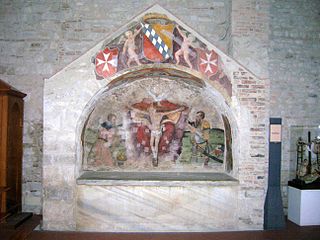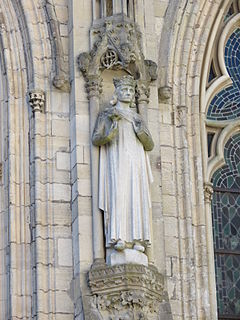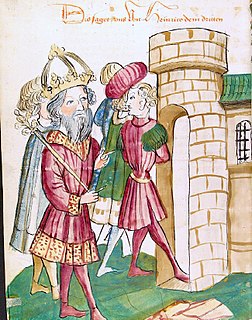
The Battle of Civitate was fought on 18 June 1053 in southern Italy, between the Normans, led by the Count of Apulia Humphrey of Hauteville, and a Swabian-Italian-Lombard army, organised by Pope Leo IX and led on the battlefield by Gerard, Duke of Lorraine, and Rudolf, Prince of Benevento. The Norman victory over the allied papal army marked the climax of a conflict between the Norman mercenaries who came to southern Italy in the eleventh century, the de Hauteville family, and the local Lombard princes. By 1059 the Normans would create an alliance with the papacy, which included a formal recognition by Pope Nicholas II of the Norman conquest in south Italy, investing Robert Guiscard as Duke of Apulia and Calabria, and Count of Sicily.

George Maniakes was a prominent general of the Byzantine Empire of Armenian origin during the 11th century. He was the catepan of Italy in 1042. He is known as Gyrgir in Scandinavian sagas. He is popularly said to have been extremely tall and well built, almost a giant.

The Catepanateof Italy was a province of the Byzantine Empire from 965 until 1071. At its greatest extent, it comprised mainland Italy south of a line drawn from Monte Gargano to the Gulf of Salerno. Although north of that line, Amalfi and Naples maintained allegiance to Constantinople through the catepan. The Italian region of Capitanata derives its name from katepanikion.

William I of Hauteville, known as William Iron Arm, was a Norman adventurer who was the founder of the fortunes of the Hauteville family. One of twelve sons of Tancred of Hauteville, he journeyed to the Mezzogiorno with his younger brother Drogo in the first half of the eleventh century (c.1035), in response to requests for help made by fellow Normans under Rainulf Drengot, count of Aversa.

Drogo of Hauteville was the second Count of Apulia and Calabria (1046–51) in southern Italy. Initially he was only the leader of those Normans in the service of Prince Guaimar IV of Salerno, but after 1047 he was a territorial prince owing fealty directly to the Emperor.
Argyrus was a Lombard nobleman and Byzantine general, son of the Lombard hero Melus. He was born in Bari.
Rainulf Drengot was a Norman adventurer and mercenary in southern Italy. In 1030 he became the first count of Aversa. He was a member of the Drengot family.

Pandulf IV was the Prince of Capua on three separate occasions.
Melus was a Lombard nobleman from the Apulian town of Bari, whose ambition to carve for himself an autonomous territory from the Byzantine catapanate of Italy in the early eleventh century inadvertently sparked the Norman presence in Southern Italy.
Arduin the Lombard was a Greek-speaking Lombard nobleman who fought originally for the Byzantines on Sicily and later against them as the leader of a band of Norman mercenaries.
Michael Dokeianos, erroneously called Doukeianos by some modern writers, was a Byzantine nobleman and military leader, who married into the Komnenos family. He was active in Sicily under George Maniakes before going to Southern Italy as Catepan of Italy in 1040–41. He was recalled after being twice defeated in battle during the Lombard-Norman revolt of 1041, a decisive moment in the eventual Norman conquest of southern Italy. He is next recorded in 1050, fighting against a Pecheneg raid in Thrace. He was captured during battle but managed to maim the Pecheneg leader, after which he was put to death and mutilated.
Hugh Tubœuf or Tudebusis was a Norman adventurer who went to Southern Italy around 1030 in search of glory and riches.

The Italo-Normans, or Siculo-Normans (Siculo-Normanni) when referring to Sicily and Southern Italy, are the Italian-born descendants of the first Norman conquerors to travel to southern Italy in the first half of the eleventh century. While maintaining much of their distinctly Norman piety and customs of war, they were shaped by the diversity of southern Italy, by the cultures and customs of the Greeks, Lombards, and Arabs in Sicily.
Dattus was a Lombard leader from Bari, the brother-in-law of Melus of Bari. He joined his brother-in-law in a 1009 revolt against Byzantine authority in southern Italy.

The Norman conquest of southern Italy lasted from 999 to 1139, involving many battles and independent conquerors.
The siege of Bari took place 1068–71, during the Middle Ages, when Norman forces, under the command of Robert Guiscard, laid siege to the city of Bari, a major stronghold of the Byzantines in Italy and the capital of the Catepanate of Italy, starting from 5 August 1068. Bari was captured on 16 April 1071 when Robert Guiscard entered the city, ending over five centuries of Byzantine presence in Southern Italy.

Wars between the Normans and the Byzantine Empire were fought from c. 1040 until 1185, when the last Norman invasion of the Byzantine Empire was defeated. At the end of the conflict, neither the Normans nor the Byzantines could boast much power as by the mid-13th century, exhaustive fighting with other powers had weakened both, leading to the Byzantines losing Asia Minor to the Ottoman Empire in the 14th century, and the Normans losing Sicily to the Hohenstaufen.

The County of Apulia and Calabria, later the Duchy of Apulia and Calabria, was a Norman state founded by William of Hauteville in 1042 in the territories of Gargano, Capitanata, Apulia, Vulture, and most of Campania. It became a duchy when Robert Guiscard was raised to the rank of duke by Pope Nicholas II in 1059.

The Battle of Montemaggiore was fought on 4 May 1041, on the river Ofanto near Cannae in Byzantine Italy, between Lombard-Norman rebel forces and the Byzantine Empire. The Norman William Iron Arm led the offence, which was part of a greater revolt, against Michael Dokeianos, the Byzantine Catepan of Italy. Suffering heavy losses in the battle, the Byzantines were eventually defeated, and the remaining forces retreated to Bari. Dokeianos was replaced and transferred to Sicily as a result of the battle. The victory provided the Normans with increasing amounts of resources, as well as a renewed surge of knights joining the rebellion.
The Battle of Montepeloso was fought on 3 September 1041 between Lombard-Norman rebel forces and the Byzantine Empire, near Montepeloso in southern Italy. The Byzantines, led by Exaugustus Boioannes, were forced into battle by the rebels, and after a day-long fight the rebels defeated the Byzantine army and captured Boioannes. The decisive rebel victory forced the Byzantines to retreat to the coastal cities, leaving the Normans and Lombards in control of the whole interior of southern Italy.










